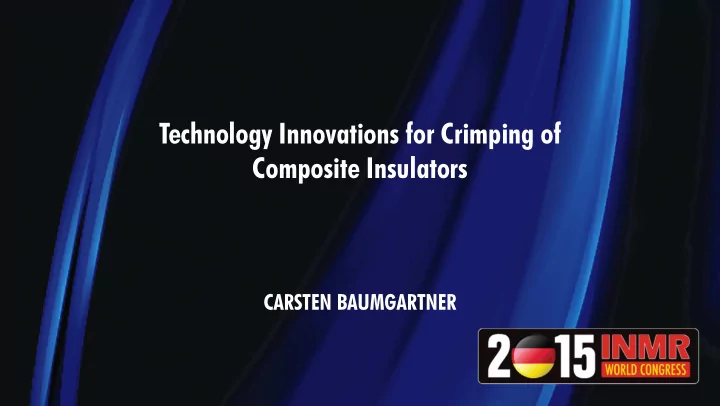

Technology Innovations for Crimping of Composite Insulators CARSTEN BAUMGARTNER
UNIFLEX – Hydraulik GmbH Machines for insulator manufacturing October 2015 www.uniflex.de 1
Welcome Carsten Baumgartner Head of engineering and production Uniflex Hydraulik GmbH, Karben, Germany Technology innovations for crimping of composite insulators October 2015 www.uniflex.de 2
Content 1. Introduction 2. Current technology 3. Development objectives 4. Development milestones 5. Basic principles 6. Evaluation of test results 7. Forecast 8. Summary and conclusion October 2015 www.uniflex.de 3
Introduction Composite longrod insulators are used as state of the art for several applications. Radial crimping machines are used for joining of longrod insulators. Different process control systems are market used for reliable and continous product quality. October 2015 www.uniflex.de 4
Current technology Longrod composite insulators • Near term customized design for flexible adaption to individual requirements • Reliable technology • Approved ratio between weight, lifetime, costs and performance • Wide market availabilty of suppliers October 2015 www.uniflex.de 5
Current technology Uniflex crimping machines • Machines up to 20000KN crimping force • Slide bearing technology • Fixed 6 o‘clock master die • Simple process implementation • In-house Engineering, design and service • Uniflex expericence since over 40 years October 2015 www.uniflex.de 6
Current technology Process control systems and related limits • Crimp to diameter • Simple – but no inference of product quality • Pressure controlled crimping • Product optimized crimping speed • Force related to product behaviour • Crack detection possible • Real crimping force dependent on equipment condition and environment • Impact sound analysis for crack detection • Complicated for installation and operation • Sensitive against environmental influences • Frequently detection errors October 2015 www.uniflex.de 7
Development objectives Improvement of crimping process for approved insulator manufacturing, based on experience and knowledge Detection of faulty insulators without additional quality costs effort Cycle time reduction for insulator manufacturing Easy installation and operation Independency of environmental influences October 2015 www.uniflex.de 8
Development milestones Evaluate system for detection and control of real crimping force translated to workpiece Search for applicable and reliable components • Sensors • Control unit • Actuator unit Review system function at field test conditions October 2015 www.uniflex.de 9
Establish basic principles Hardware • Uniflex HM 380 crimping machine • Measuring processor unit: sampling rate 10KHz • High speed proportional valve for fast response October 2015 www.uniflex.de 10
Establish basic principles Sensor • Force measuring pin / type full bridge Sensor application • 6 o‘clock master-dies • Crimping dies Quantity of sensors • 2 sensors: front and back October 2015 www.uniflex.de 11
Evaluation of test results – Symmetric force transmission to crimping dies • Master-die can be used for qualified measurement October 2015 www.uniflex.de 12
Evaluation of test results Linearity between pressure and force • Hydraulic pressure is not linear to real crimping forces • Pressure is no reliable indicator for insulator failure • Pressure cannot be used for qualified evaluation of crimping process October 2015 www.uniflex.de 13
Evaluation of test results – Repeatability at serial production • Crimp to pressure: force variation up to +/- 25% • Crimp to force: specified force transmission to workpiece October 2015 www.uniflex.de 14
Evaluation of test results – Failure detection at manufacturing process • Sample batch analysis for force range detection • Continous and reliable process control while manufacturing October 2015 www.uniflex.de 15
Evaluation of test results – Real force calibration • Load cell sensor for reference forces • Required work-piece forces can be translated between different machines October 2015 www.uniflex.de 16
Forecast – Detection of • Correct positioning at master-die • Proper preassembling of work-pieces • Regular combination of rod and fitting • Inhomogeneity of insulators raw material October 2015 www.uniflex.de 17
Summary and conclusion – Real force controlled crimping for qualified process control – Optimized crimping result and reduced cycle time – Fixed 6 o‘clock master die for permanent and protected sensor application – Symmetric force transmission to crimping dies Independency of environmental influences, such as friction, temperature, noise or machine service situation – Redundancy by application of two force sensors – Mechanical insulator crack detection without absorption by hydraulic oil – Easy installation and operation – Approved crimping parameters exchangeable between different machines by force calibration October 2015 www.uniflex.de 18
Uniflex Hydraulik GmbH Thank you for your kind attention. - see you at booth S1- www.uniflex.de October 2015 www.uniflex.de 19
Recommend
More recommend